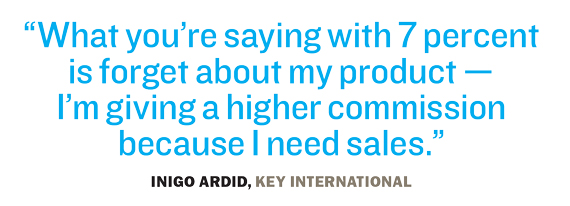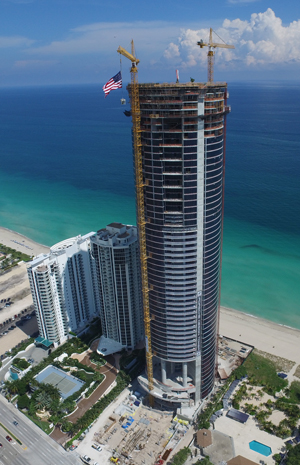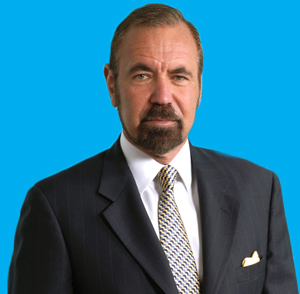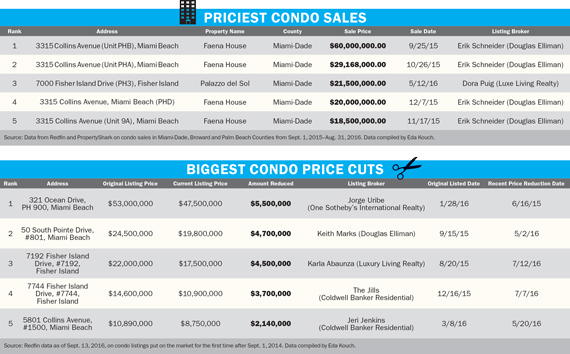When Argentinian developer Alan Faena announced an ambitious high-end condo project in Miami Beach three years ago, the area’s housing market was riding a towering wave of rising values as it recovered from the 2008 crash.
In the years after its launch, Faena House became a symbol of the heights to which developers could take the luxury market, shattering Miami-Dade’s residential price record with the $60 million sale of its penthouse and selling out its lower units to a who’s who of Wall Street bigwigs.
But four months after hedge fund honcho Ken Griffin closed on Faena’s duplex penthouse and the unit beneath it in September 2015, he placed the them back on the market for a total of $73 million. He offered little explanation, with his listing agent Eloy Carmenate of Douglas Elliman saying only that Griffin had changed his plans.
Considering broker costs, closing fees and a possible price cut of up to 10 percent, Griffin would not have profited much from the deal. “You’re almost talking about the guy getting out at par or making out with a couple million bucks on a huge check,” Key International Co-President Inigo Ardid said.
Not long after news broke of Griffin’s sprint for the exit, resale inventory began piling up at the 18-story tower. By early August, $148 million worth of Faena condos were up for grabs, representing about 20 percent of the units in the tower. Some of those have lingered on the MLS for a year now.

The same is true for many of Miami’s shiny new luxury buildings. By the count of development tracker CraneSpotters.com, there were nearly 11,000 condo listings (not including preconstruction) in Miami-Dade County east of I-95 in late August. The average asking price was just north of $1 million, or $572 per square foot.
“That product has gotta clear the market,” said Anthony Graziano, senior managing director of research firm Integra Realty Resources, noting that it was competing with buyers who might otherwise buy preconstruction units.
The effects of that inventory buildup are already being felt, as some major developers hit the pause button.
The Related Group, considered South Florida’s most prolific and well-capitalized condo developer, has quietly delayed its massive three-tower Auberge Residences & Spa Miami project amid stagnating sales in August. Even with prices starting at $350,000, undercutting much of its competition in the Arts & Entertainment District of Miami’s downtown area, preconstruction sales totaled only 15 percent of the first tower’s planned 290 units seven months after launching the sales campaign. Although the developer had originally expressed the desire to begin construction in early 2017, as of September it had not announced a new groundbreaking date.
A similar but seemingly more dire scenario is playing out at Boulevard 57, the Upper East Side project backed by Venezuelan oil tycoon Gerardo Pantin Shortt that canceled sales of its 107 units earlier this year after buyers reserved little more than 10 percent of its inventory. Unitas Development Group, the project’s sponsor, maintained that its retail portion was expanding and moving forward, but sources close to the project say the entire two-acre development site is being marketed with a $26 million ask.
Taking stock
With sales slow and plenty of competition, many of Miami’s biggest developers are facing a difficult decision: Launch now and risk failure, or bide time until the next demand cycle, which could take years to materialize.

Sales started in 2013 for the 57-story Porsche Design Tower, located in Sunny Isles Beach, and most of the units have closed.
According to a second-quarter development survey from International Sales Group, 77 percent of the 14,316 units in the pipeline were sold as of June. Though the pipeline’s expansion by about 500 units helped dilute any growth in sales, that ratio still barely budged from the 76 percent that Miami stood at after the first three months of 2016.
“Nobody really hit their January, February or March projections, because things started slowing down last year,” Graziano said. “If you can’t get to your presale threshold within a year or two, you’re probably not going to start presales today.”
That same reasoning has led PMG to delay its launch of 300 Biscayne, a planned supertall condo tower approved by the FAA last year to hit 1,049 feet — higher than any building in Miami’s skyline today.
“We would’ve probably gone to market with it already if the market was healthier,” said PMG Principal Ryan Shear. “Launching a new product today is a tough choice to make. We’ve elected not to.”
As evidenced by the Auberge and Boulevard 57 projects, among others, they’re clearly not alone. A spokesperson for Related said in January that the firm was expecting to launch the first phase of its massive One Brickell mixed-use project at 444 Brickell Avenue, with a planned build-out of 1,200 residential units and a 200-room hotel, within the following few months. Those expectations appear to have changed. By September, the firm had yet to make a follow-up announcement about the property.
As for PMG, Shear said his firm is in no rush to get out the door with its latest project. The developer is still clearing out the remaining inventory at its four South Florida projects, including Echo Brickell and Muse, which are under construction, as well as its completed projects Echo Aventura and Sage.
“I hate to say this, but we were lucky,” Shear said. “It’s definitely not as fast as it was, and there’s definitely been some price depression.”
All four of those projects were launched during the boom period between late 2012 and 2014, when preconstruction sales were lightning fast, and their remaining units add up to less than 75 condos.
The firm is still moving forward with its apartment tower formerly known as Vice, which broke ground on the same block as 300 Biscayne in May. PMG is hoping demand among millennials for luxury rentals will fill its 464 units, which start at $1,800 a month.
Across Biscayne Bay, Gil Dezer is in a similarly fortuitous position. His firm, Dezer Development, launched sales in early 2012 for its 57-story flagship project of this cycle, the Porsche Design Tower in Sunny Isles Beach. Only five of the project’s 132 units remain on the market, including the penthouse, which is priced at $33 million.
Dezer is also working to sell the remaining 30 percent of the 308-unit Residences by Armani/Casa development in Sunny Isles Beach, which he’s developing in partnership with Related. The project is slated to open by 2019. “To sell 30 percent over 3 years, that’s not going to be a problem,” he said.
Though the majority of Miami’s preconstruction pipeline is presold, the projects with leftover units at opening will be entering a market that’s already struggling with oversupply and a staggering drop in sales volume since 2015.

Related CEO Jorge Perez
The downtown Miami condo market recently saw its first decline in average pricing per square foot in five years, as it contended with more than 3,000 active listings in Greater Downtown Miami alone. And Miami-Dade’s housing market as a whole is down shifting from the overheated boom years, with July 2016 figures from the Miami Association of Realtors showing that home and condo sales combined had fallen nearly 21 percent over the previous year.
Second-quarter data from consulting firm Miller Samuel indicates a solid portion of that softness is at the top of the market. The number of closings for homes and condos priced between $1 million and $2 million fell 17 percent year over year, from 358 properties to 296. Homes between $2 million and $3 million fared even worse, with sales dropping 36 percent, from 131 to 83.
A slower real estate market isn’t necessarily a bad thing, though. Jonathan Miller, president of Miller Samuel, said sales and prices in Miami exploded during 2014 and 2015. So if this year is comparatively sluggish, he said, that could signal a return to normalcy — and stability.
For developers, Shear said, the hope is that a lack of new projects launching will narrow the condo pipeline and give Miami much-needed time to absorb the excess inventory.
“Down cycles are great because they bring the cost of construction down, which is a huge benefit, and it resets the bar for everybody,” Shear said. “It kinda clears out the cobwebs; if you want to play in the tougher market, you have to have a lot of cash and be a strong developer.”
Sales gimmicks
But while some firms are content to wait for what inventory they have left to be absorbed, others are looking to bring in new business as quickly as possible. That means raising commissions to entice brokers, and in some cases lowering required buyer deposits from the 50 percent gold standard that’s become so pervasive this cycle.
In March, the joint venture behind North Miami Beach’s Marina Palms condo project boosted commissions to 7 percent from 6 percent to help clear out the 468-unit development’s last 40 units.
In January 2016, Related bumped commissions to 10 percent at two of its projects in Greater Downtown Miami, the Brickell Heights 02, which was 89 percent sold out, and SLS Lux, which was 95 percent sold.
Though these cases involved projects that were already out of the ground and approaching sellout, for some in the industry, the moves set off warning bells.
“It sends terrible signals to the market, that you can’t sell, that you’re desperate,” said Key International’s Ardid. “What you’re saying with 7 percent is forget about my product — I’m giving a higher commission because I need sales. Bring buyers here because you’ll get paid more.”
When the real estate bubble popped in the late 2000s, swaths of Miami condo buyers walked away from their 20 and 30 percent deposits, drowning developers in empty and foreclosed units.
It was after the smoke began clearing in 2010 and 2011 that Miami’s builders began looking to their counterparts in South America for inspiration. Virtually every condo project there used deposits higher than 50 percent, and it wasn’t long before the practice was adopted stateside.
Ardid said the heavy deposits helped protect projects on two fronts: More cash from buyers means developers can rely less on lenders to fund construction, and with more skin in the game, buyers are less likely to bail from a unit before closing.
Related, credited by some as the first to adapt South America’s methodology, was also one of the first firms to relax that requirement in the past year.
At Brickell Heights and SLS Lux, the same two projects where it raised commissions, the developer shaved deposit requirements down to 30 percent. Competitors like the Melo Group balked. But others, like PMG and Swire Properties, attempted to lure buyers away from other buildings by becoming more flexible about scheduling installment payments to make the 50 percent deposits before closing.
“We just want to sell out the remaining inventory, which obviously is priced higher, and move to the next projects,” Carlos Rosso, president of Related’s condominium division, said at the time.
Foreign buyer effect
Miami has a long history of attracting wealthy foreigners to its sandy shores, especially from Latin American countries, whose investors snapped up discounted condos left and right during the financial crisis.
Throughout the latest building boom, the local housing market’s reliance on foreign buyers was at full force. Between August 2014 and August 2015, foreign buyers accounted for $6.1 billion, or 36 percent, of South Florida’s total home sales volume. They also helped ease the growing pains of Miami’s transition to 50 percent deposits, as Latin Americans weren’t shy about putting up that much money, unlike American condo buyers.
Above anything else, real estate players point to the dwindling interest from these buyers as the main cause of South Florida’s struggling condo market.
“It’s the single biggest reason that’s holding back a robust condo market right now in Miami,” said Craig Studnicky, a principal at ISG. “With the dollar trading as high as it is, our assets are very, very expensive for foreign buyers.”
Price appreciation is also playing a role in the decreased appetite. Median residential prices in Miami-Dade for both existing single-family homes and condos had risen for nearly five straight years as of July, according to figures from the Miami Association of Realtors. For foreigners, the combination of high housing costs and unfavorable exchange rates makes buying an investment property and renting it out much less lucrative, Studnicky said.
In addition to those issues, many Latin American buyers are also facing economic instability at home, especially in countries where many of Miami’s condo buyers hail from, like Brazil and Venezuela.
To be sure, there are signs that the Brazilian economy may be stabilizing. In late summer of this year, the Brazilian real had been gradually climbing in value against the U.S. dollar. However, Venezuela is in a deep political crisis with middle-class families raiding grocery stores amid food shortages, and mass protests against President Nicolas Maduro.
Foreign buyers are still investing in Miami real estate, just not as noticeably, said Bijou Bay Harbor’s director of sales, Liza Hernandez. She conjectured that some foreign buyers were picking up properties they “could potentially move to” because of instability in their home countries.
Regardless of the political and economic uncertainty in parts of Latin America, Miami developers are already preparing for the next cycle.
In Sunny Isles Beach, Dezer has a contract on waterfront land owned by Publix that still has two years left to close. When it does, he said, he’s planning a project with units priced in the $500,000-to-$1.5 million range, which he said sells “all day long.”
Studnicky said that Related and PMG are quietly making land purchases for new developments.
“They’ve been through this movie before; they know what happens,” he said. “When the recession ends, it’s like happy days are here again. People just start coming out of the woodwork and start buying all over again.”

